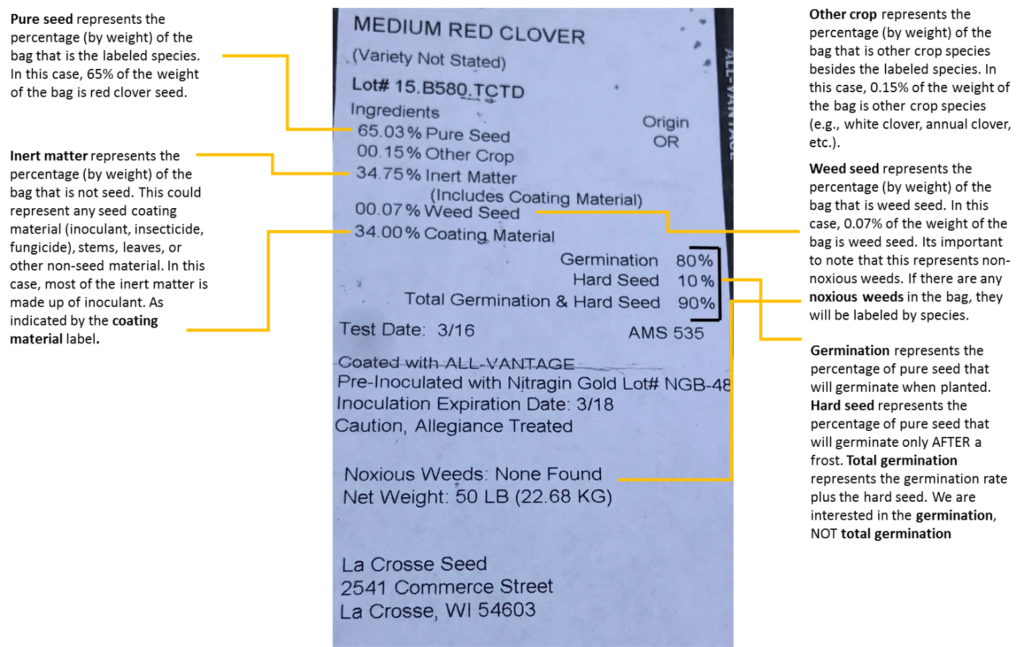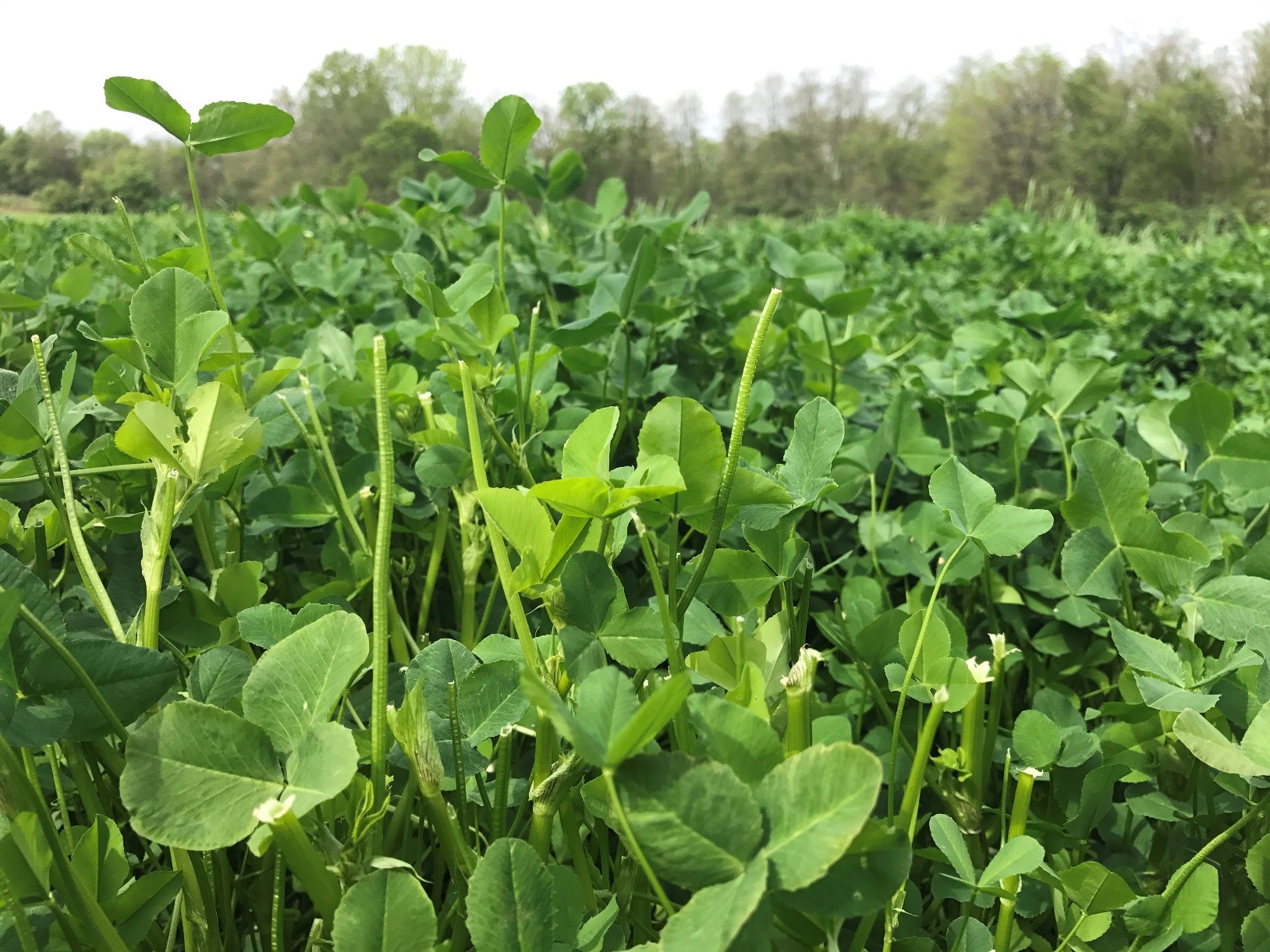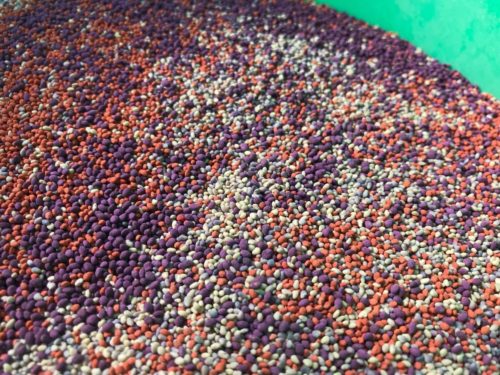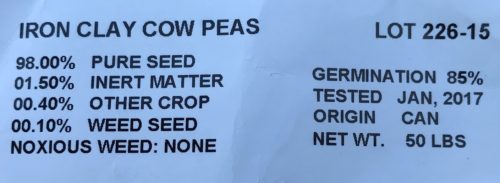 Purdue University - Extension - Forestry and Natural Resources
Purdue University - Extension - Forestry and Natural Resources
Pure Live Seed: Calculations and Considerations for Wildlife Food Plots
Have you heard the old adage “proper planning prevents poor performance?” This adage applies perfectly to establishing food plots for wildlife; you just have to adjust the words, “Proper planting prevents poor food plot performance”.
When we talk about planting we include planting method, timing, depth, and planter calibration (see video), but we also include seeding rate. While there are many steps prior to planting to ensure a successful food plot, including taking a soil test, adjusting the soil fertility, and proper site preparation, determining the proper seeding rate based on pure live seed rather than bulk weight may be one aspect that people skip or ignore.
All agronomic seeds have a recommended seeding rate. This is the rate that maximizes forage or grain production and minimizes seed costs. Planting food plot seed too heavily is often a waste of money, because it increases your seed cost, but does not necessarily increase you forage or grain production. Planting food plots too lightly is an inefficient use of field space, opening areas up for weeds to overtake your planting, and could result in failure because of overbrowsing.
Seeding rate also varies by planting method and it’s important to make sure to follow the recommended seeding rate for the planting method you will be using. This rate is greater when broadcasting rather than when drilling or planting seed (broadcast rate: 75-100 lbs/ac vs. drilling rate: 50 lbs/ac for iron-clay cowpeas).
It is important to recognize the difference in how seed is sold (bulk weight) and how seeding rates are recommended (pure live seed [PLS]). When you buy seed from a supplier you are buying it in the form of bulk weight. Bulk weight is the total weight inside the bag, including the food plot seed, as well as the weight of the seed coating and other material (other crop seed and weed seed).
While seed is sold by bulk weight, seeding recommendations are commonly given as PLS rates. This distinction is important. For example, all the recommendations in A Guide to Wildlife Food Plots and Early Successional Plants by Dr. Craig Harper, University of Tennessee Extension are given in PLS rates. Pure live seed is the living seed of the intended crop that will germinate from a seed bag and accounts for the weight of the bag made up of impurities, weed seed, and other crop seed.
Percent PLS in a seed bag varies, depending on the amount of pure seed in the bag as well as the germination rate of that seed. It is important to know the difference between PLS and bulk weight so that you can calculate the amount of bulk weight you need to achieve the recommended PLS seeding rate.
Keep the distinction between bulk weight and PLS weight in mind when buying seed to ensure you purchase enough seed to cover the entire area of your food plot. In this article we will explain how to calculate PLS based on information given to you when you purchase seed.
Dissecting a seed tag – know what you’re getting before you purchase
Before we get too far into calculating PLS, it is important to understand what information you get when purchasing seed. Regardless of whether you buy a seed mix or a single species from a co-op, feed store, or sporting goods store, all agricultural seed sold in Indiana must come with a label – commonly called a seed tag. By law, that seed tag must contain these 12 items: 1) commonly accepted name (species) and variety, 2) lot number, 3) origin of seed, 4) company who labeled the seed, 5) percentage of pure seed (>5% of weight), 6) percentage of other crop seeds, 7) percentage of inert matter, 8) percentage of weed seed, 9) species and amount of any noxious weeds (if present), 10) germination rate, 11) hard seed, and 12) calendar month and year the bag was tested.
Important items to look for when purchasing seed are explained below.

As we can see from this red clover seed tag above, only 65% (32.5 lbs) of the 50 lb bag is actually red clover (Pure Seed). Most of the other weight is the inoculant (Coating Material; 34% or 17 lbs). Of the 32.5 lbs of red clover seed, 80% will germinate after planting (Germination). So, if you planted 15 lbs (bulk weight) from this bag (recommended PLS rate) you would actually be planting 9.75 lbs of pure seed, of which only 7.8 lbs would germinate. Meaning you would be planting a little over half the recommended rate. See why PLS is so important now?
Clover seed: bag half empty or half full?
It may seem odd to buy a 10 lb clover seed bag only to expect 5 lbs to actually grow, but in the case of legumes – like clovers – the 5 lbs in the bag that isn’t seed may actually save you money in the long run. Having as little as 50% PLS in a bag of clover is not uncommon, as much of the weight is made up of the seed coating, which is typically an inoculant. The inoculant on clover, soybeans, alfalfa, or other legumes is living bacteria that help fix nitrogen from the air and make it usable to plants. Planting inoculated seed – whether you inoculate it yourself or purchase pre-inoculated seed – reduces the amount of nitrogen fertilizer needed, ultimately saving you money on fertilizer application. The benefit of buying pre-inoculated seed is that it saves you the hassle of inoculating the seed yourself.
Calculating pure live seed (PLS)
Now that you know the importance of reading the seed tag before purchasing seed, you can now think about calculating PLS. All the information you need is right there on the tag. Using the example seed tag below locate the two items labeled “PURE SEED” and “GERMINATION”.
Our example is 98% pure seed, meaning in a 10 lb bag there are 9.8 pounds of pure iron-clay cowpea seed. The next number we will need is the germination rate; this will also be indicated as a percentage. Our example has an 85% germination rate.
To calculate percent PLS for this seed, multiply pure seed and germination and then multiply by 100 (example below). The result is the percentage of pure live seed for this bag of seed.
98% pure seed
85% germination
(0.98 x 0.85) x 100 = 83% (Percent PLS)
We now know that 83% of our bag is iron-clay cowpeas capable of germinating. Now that we have the PLS of our seed we can calculate the amount (lbs) of pure live seed in our bag. To do this, multiply the bulk seed weight by the percent PLS.
50 lb bag x 0.83 (Percent PLS) = 42 lbs PLS
For example, a 50 lb bag would equal 42 lbs of iron-clay cowpea seed that will germinate.
Determining bulk seed rate
Using the percent PLS information we can also find the amount of bulk seed necessary to plant at a recommended seeding rate. To do this, take the recommended seeding rate for your planting method and divide it by the percent PLS of the seed you are using (example below). The result is the bulk weight that you will need to plant per acre to achieve the recommended seeding rate.
50 lbs/acre = recommended seeding rate for iron-clay cowpeas when drilling
0.83 = percent PLS of seed being planted (from example above)
50/0.83 = 60 lbs/acre
In order to plant a cowpea food plot at the recommended rate of 50 lbs/acre, we will need to plant 60 lbs/acre from this particular seed bag.
Another benefit of calculating pure live seed? Comparing seed prices
Not all seeds are of the same quality. Some have lower pure seed and germination rates than others. For this reason, it is not always most cost effective to buy the cheapest bag of seed on the shelf. If you wish to compare pure live seed prices between seed bags, first divide the price of the bag by the weight of the bag. This will give you the price per pound of bulk seed (example below). Now divide this price per pound by the percent PLS of the seed. The result is the price per pound of PLS.
Seed Manufacturer X 10lbs
Pure seed 97%
Germination 92%
Price $33
PLS (0.97 x 0.92) x 100 = 89%
$/lb (bulk) 33/10 = $3.30/lb
$/lb (PLS) 3.3/0.89 = $3.70/lb
Seed Manufacturer Y 10lbs
Pure seed 91%
Germination 82%
Price $30
PLS (0.91 x 0.82) x 100 = 74.%
$/lb (bulk) 30/10 = $3/lb
$/lb (PLS) 3.0/0.74 = $4.05/lb
According to these calculations, seed manufacturer X is actually a better value than Y. Using this process, especially when purchasing seed in bulk, you can be a practical money saver.
Let’s Plant
Now that you know what all those numbers on the seed tag of your favorite food plot seed mean and you know how to calculate PLS, you will be able to plant your food plots at the most effective rate possible. Remember, regardless of whether you are planting acres of soybeans with a no-till drill or frost seeding a ½-acre clover patch, knowing how to calculate PLS will allow you to be more successful and save money when planting food plots.
Other Resources:
Seed Fillers and Carriers for Planting Native Warm-Season Grasses and Forbs, Detailed Resource, Purdue Extension-FNR
Renovating Native Warm-Season Grass Stands for Wildlife: A Land Manager’s Guide, free pdf download
VIDEO: Calibrating a No-Till Drill for Conservation Plantings and Wildlife Food Plots
VIDEO: Frost Seeding to Establish Wildlife Food Plots & Native Grass and Forb Plantings
Printable Version:
PDF available for print: Pure Live Seed: Calculations and Considerations for Wildlife Food Plots (pdf 636.75) detail resource.
Moriah Boggess, Purdue Extension Wildlife Intern
Jarred Brooke, Purdue Extension Wildlife Specialist

Recent Posts
- Extension Specialist Lenny Farlee Earns National Recognition
Posted: October 1, 2024 in Forestry, Plants, Urban Forestry, Wildlife, Woodlands - Hardwood University Offers Classes to Industry Professionals
Posted: September 24, 2024 in Forestry, Forests and Street Trees, How To, Woodlands - Rebuilding Indiana’s Hellbender Habitat – Morning AgClips
Posted: September 17, 2024 in Forests and Street Trees, Urban Forestry, Wildlife - Purdue Alumnus Magazine Highlights FNR Graduate and Nature of Teaching Program
Posted: September 13, 2024 in Got Nature for Kids, Nature of Teaching, Wildlife - Enjoy Your Trees While Checking Them – Purdue Landscape Report
Posted: September 12, 2024 in Forestry, Forests and Street Trees, Urban Forestry, Wildlife, Woodlands - IN DNR Division of Entomology & Plant Pathology Shares Kudzu Program
Posted: September 9, 2024 in Forestry, How To, Invasive Plant Species, Plants, Uncategorized, Wildlife - Reserved Hunt Applications Now Open – MyDNR
Posted: September 4, 2024 in Forestry, Wildlife, Woodlands - What the Fluff?! – Purdue Landscape Report
Posted: September 3, 2024 in Forestry, Invasive Plant Species, Plants, Urban Forestry, Wildlife, Woodlands - Announcing-New Indiana Woodland Steward Newsletter
Posted: September 2, 2024 in Forestry, Timber Marketing, Wildlife, Woodlands - The Summer of Triclopyr – Purdue Landscape Report
Posted: August 21, 2024 in Disease, Forestry, Forests and Street Trees, Invasive Plant Species, Urban Forestry, Wildlife
Archives
Categories
- Alert
- Aquaculture/Fish
- Aquatic/Aquaculture Resources
- Ask the Expert
- Christmas Trees
- Community Development
- Disease
- Drought
- Forestry
- Forests and Street Trees
- Gardening
- Got Nature for Kids
- Great Lakes
- How To
- Invasive Animal Species
- Invasive Insects
- Invasive Plant Species
- Land Use
- Natural Resource Planning
- Nature of Teaching
- Plants
- Podcasts
- Ponds
- Publication
- Safety
- Spiders
- Timber Marketing
- Uncategorized
- Urban Forestry
- Webinar
- Wildlife
- Wood Products/Manufacturing
- Woodland Management Moment
- Woodlands


